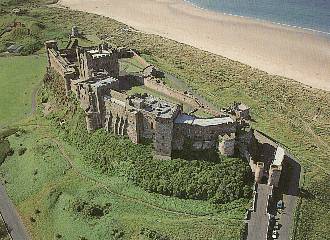 |
 |

Bamburgh Castle
[Monday - 05/03/99] We crossed over into England this morning in search of Lancelot's castle, Joyous Garde, and his supposed resting place. Sir Thomas Malory, in his great Arthurian romance of the fifteenth century, Le Morte d'Arthur, mentions both Bamburgh Castle and Alnwick Castle (next page): "Some men say it was Anwick and some men say it was Bamborow." We figured, we'd check them both out this morning on our drive south.
While it killed us to have to ignore the signs for Lindisfarne and stay our course, our diligence was rewarded when we saw Bamburgh Castle towering above the tiny village of the same name on the bare, sandy coastline of Northumberland. To say it was breathtaking is an understatement. Still the private home of the Lord Armstrong and his family, it housed an interesting array of collections and has been extensively modified relieving of it of much of its charm or Arthurian romance. Still, we could capture some nuance of the Castle's history while visiting the original Keep Hall and its original, underground works.
Interestingly, in the Dark Ages, after the Romans left Britain, Northumberland was first known as Bernicia and was ruled by various Anglo-Saxon kings. They are known to have had at least three castles. Two of these were at Ad Gefrin and Maelmin north of Wooler. The third was at Bamburgh, on the same site as the present castle which became the capital of the Northumbrian 'kingdom' in 547 AD.
The Anglo-Saxons were, of course, regarded as invaders by the native Celtic Britons and were Arthur's prime enemies in his fight to maintain British rule. It was on the Milfield Plain that Arthur is supposed to have fought and won one of his greatest battles against the Anglo-Saxons and the Picts (from present day Scotland), after which he took possession of at least one Angle castle – at Bamburgh. Legend relates that it was Bamburgh Castle that Arthur then gave to Sir Lancelot, in recognition of his defense of Queen Guinevere, and which Lancelot called "Joyous Garde". It was also here that the runaway lovers Tristan and Iseult took refuge. The legend may well be true for the Celtic name for Bamburgh was "Din Gardi".
|
Last modified on Wednesday, November 26, 2008 URL: http://www.housecorvus.org/bam.htm Copyright © 1999, 2000-09 House Corvus. All rights reserved. Design and hosting by Bran Trefonnen. | |